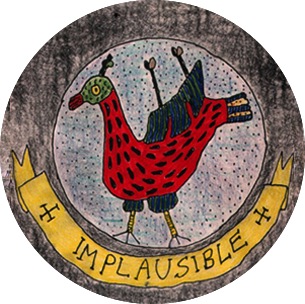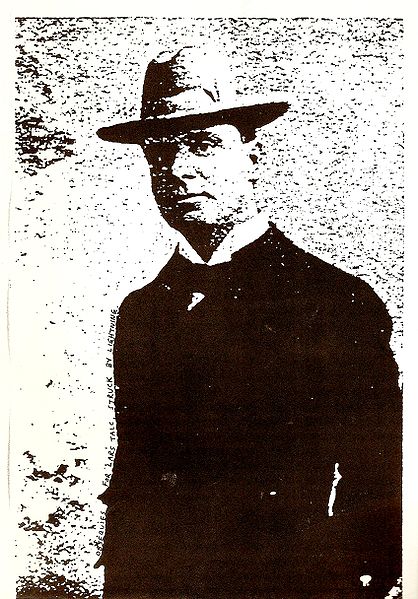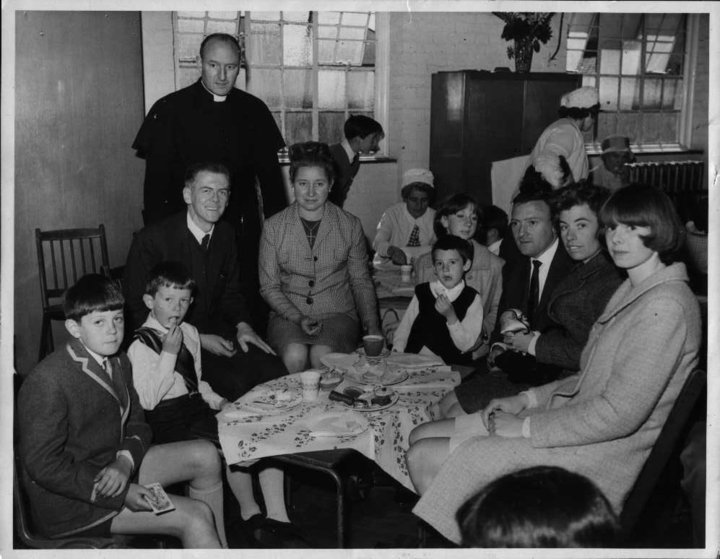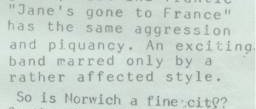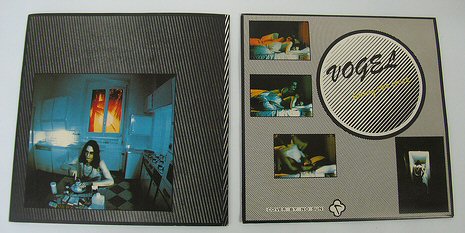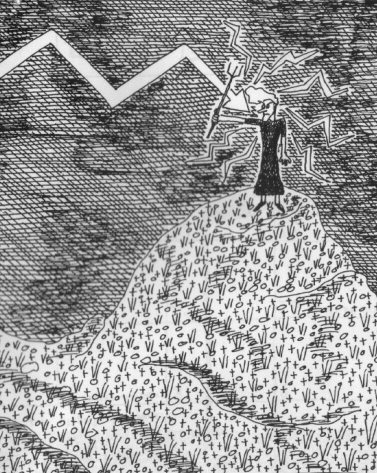A ghoul from the 1994 Hooting Yard Calendar
Category Archives: Speak, Memory!
Nisbet Spotting Addendum
Dear Mr Key, writes Dr Ruth Pastry, I read yesterday’s piece about nisbet spotting and put two and two together. I think the “hapless enthusiasts” of the Nisbet Spotting Society were seeking high and low for that odd being depicted in the Hooting Yard “implausible” emblem, as shown in the heading of your website and on those fetching lapel accoutrements. My unpaid intern research assistants tell me that the emblem first appeared, in black and white, on the cover of an edition of the ReR Quarterly magazine in the late 1980s, cheek by jowl with several other emblems. If this is the case, then in terms of simple chronology it would have been impossible for nisbet spotters of the early 1970s to spot it, as it did not yet exist. Had you had a bit of stamina and kept up regular production of the Official Journal of the Nisbet Spotting Society, those hapless enthusiasts would not, with the passing of time, have been quite so hapless. Yours indefatigably, Dr Ruth Pastry.
Dr Pastry is correct about the provenance of the emblem. If any reader has a copy of the magazine in question, perhaps they would be good enough to scan both front and back covers and send them to Mr Key. On the question of whether or not the “odd being” is indeed a nisbet, I think it best to reserve judgement until a panel of experts has been empanelled to consider the matter with due diligence.
In Praise Of Nisbet Spotting
Reading a couple of blog postages today led me to cast my mind back to the heyday of nisbet spotting in the early nineteen-seventies. In The Dabbler, ZMKC fondly recalls an absurd and pointless exchange of correspondence with a schoolfriend, while BlackberryJuniper And Sherbet apologises (unnecessarily) that she is “thinking aloud about nothing in particular”.
Absurdity, pointlessness and “nothing in particular” as one’s subject matter all dovetail neatly into the theory and practice of nisbet spotting. I earlier gave some account of this exciting activity here. To recap, aged around ten or eleven, I created a newspaper or magazine which purported to be the Official Journal of the Nisbet Spotting Society. Written by hand, illustrated with drawings and collages, the pages carefully stapled together – though not with fairy staples – the contents of the Journal chronicled the failure of the Society’s members ever to spot a nisbet. Indeed, I made it a conscious point never to explain what a nisbet was. I suppose it was my version of the Snark or the Boojum, though I don’t think I had read Carroll’s “Agony In Eight Fits” at the time.
Did the nisbet even exist, or were those seeking to spot one on a futile quest? We shall never know, for before I faced up to deciding one way or another, I abandoned the Journal after five or six issues and discovered other enthusiasms. I continued to write, though I don’t remember what. Then soon enough I entered the dread world of teendom, and became very serious and earnest, as teenpersons will do, and my writing suffered accordingly. I had an important message for the world, if only it would listen. It did not.
It took about ten years for me to regain my mojo, and to realise that the absurdity and pointlessness and “nothing” of nisbet spotting showed the way forward. To a large extent, everything I have written over the past quarter of a century, since the first Malice Aforethought Press booklet in 1986, has been a sort of hommage to those hapless enthusiasts of the Nisbet Spotting Society.
Obsequies For Lars Talc, Struck By Lightning
This is the cover of Obsequies For Lars Talc, Struck By Lightning. It was published in an edition of twenty-five copies in 1994, under the Hooting Yard Press imprint and – save for a brief, rewritten, extract posted here some years ago – has never again seen the light of day. It was the last piece of prose I completed before my descent into the maelstrom, or the Wilderness Years, or whatever one wants to call that period of ruination from which I eventually emerged with the launch of the Hooting Yard website in 2003.
I am planning to republish Obsequies, with the original text unaltered, as the second volume in the Out Of Print Pamphlets Reprinted series, later this year. Meanwhile, I have decided to read the whole thing on the radio, starting with this evening’s episode of Hooting Yard On The Air on Resonance104.4FM, continuing next week, and possibly the week after. (I’m not sure how long it will take.)
Turn on, tune in, pin back your ears, and listen.
Young Mr Key, Ensashed
Further to yesterday’s photograph of my mother, here is another snap from yesteryear. Click for a (slightly) larger version.
Lydia Stephania, 1925-1994
Your Capitalist Music Cuttings For Today
No luck as yet with the decipherment of the great Steve Bloch’s lyrical sally in “Jane’s Gone To France”. But for those of you keen to see the resurrection of perhaps the most important beat combo ever to mention Marshal Petain in a song, here are some cuttings culled from distant outposts of Interwebshire.
First, two reviews of the magnum opus itself, from a couple of local rags. Please note that a young Mr Key did not write either of them.
Second, unfortunately as low in resolution as he was high in importance, Bloch himself, on stage.
The Land Of Cheese And Wine
I have been called many things in my time – “Mr Key” and “a Diogenesian recluse” are two that spring to mind – but the one I particularly treasure is “the anti-Capitalist Music journalist”. Alas, the tiny speck of Interwebshire where these words appeared has vanished. Let us hope it pops up again somewhere one day.
Capitalist Music were an endearingly preposterous band, based in Norwich, in those heady post-punk days circa 1979-1982. Their chief characteristic, as I recall, was an almost boundless self-importance. For the crime of having given them a so-so review in a local rag, I earned my immortal epithet. Not “an” anti-Capitalist Music journalist, note, but “the” (as if they were otherwise universally adored), and the implication that my opinion of them was the defining fact about me. I may have been scribbling reviews of other bands, and of films, and bashing out a cartoon strip, but what did that matter? Surely everybody knew me as “the anti-Capitalist Music journalist”.
But was I, truly? After all, here I am writing about them thirty years later. The reason for doing so is basically a plea for help. For me, the band’s finest work was the ludicrous “Jane’s Gone To France”, with its rousing lines “It’s the land of cheese and wine / It’s the land of Marshal Petain!” Yet no matter how efficiently I sluice out my ears with Dr Baxter’s Ear-Sluicing Preparation, I have never, ever been able to work out what on earth the great Steve Bloch is singing in the next line. So in a desperate attempt to solve this puzzle that has haunted me for three long decades, I am posting the song here. Have a listen, and when you have calmed down sufficiently, and stopped giggling, do let me know what you think that line is.
Jane’s gone to France
It’s the land of cheese and wine
And it’s the land of Marshal Petain
And it’s the land of [what, for God’s sake?]
She was a good girl
But now she’s gone for good
Capitalist Music – Jane’s Gone To France
from the 1981 compilation album “Welcome To Norwich A Fine City”
Overseas Jesuit
Mention of Dr Charlotte Bach’s tragically unrealised Aztec board game summoned to memory a family favourite from my childhood. Overseas Jesuit was a board game in which one rolled the dice and moved one’s counter across various dark and benighted continents, converting the heathen hordes by fire and sword. So simple were the rules that the game was suitable for even the tiniest young Catholic.
Arschloch
For no particular reason, Vogel with the late Ivor Cutler. Genius at work.
Arschloch (click to listen)
Thunderbolt!
Graveyard Anecdote, With Nuns
Fossicking in a cupboard the other day, I came upon a piece of writing I’d done late in the last century. It contains a splendid anecdote which I can now share with you:
In 1994 my sister, who lives in the United States, was on a visit back to England for a couple of weeks. One day we decided to pay a visit of homage to St Patrick’s Roman Catholic cemetery in Leytonstone, wherein lie buried the five Franciscan nuns whose drowning in the mouth of the Thames in December 1875 was the event which sparked Gerard Manley Hopkins to write The Wreck Of The Deutschland. It was an overcast day in late summer, and we trudged aimlessly around the stones, unclear as to what sort of tomb or edifice we were looking for. It is a fairly small cemetery, and after half an hour or so we were on the point of abandoning the search – I think it was beginning to rain – but as we were going back towards the gates we noticed that a light was on in the shabby one-storey building near the entrance. We went in, and were greeted by some sort of cemetery attendant. My sister began, rather haltingly, to explain that we were looking for the grave of some nuns who had been drowned and whom the poet Hopkins had written a… – The attendant held up a hand to stop my sister in mid-flow and, looking over his shoulder towards an ajar door behind him, called “Oi, Mario! Them nuns what drowned…” Enter Mario, another cemetery worker, who promptly led us to the plot, asked if we were German (as the nuns had been), and explained that “quite a few people come to look at them nuns”. My sister began a brief tutorial on Hopkins, but I think Mario had heard it all before – having delivered us to our tombstone, he rapidly headed back to whatever he had been doing before. Ever since, I have mentally subtitled Hopkins’ great poem “Them Nuns What Drowned”.
Photograph courtesy of findagrave
An Immense Number Of Rabbits
A brief note to remind readers to keep abreast of my late mother’s memoir, Ghent In Wartime, which I am posting in weekly instalments as a blog. (There was a postage about it at The Dabbler, to which I also draw your attention.)
This week’s episode – rabbits and potato peelings!
Ted Volta
A while back, in his Ragbag, Gaw posted an excerpt from David Kynaston’s book Family Britain 1951-1957 recalling inhabitants of a lost world, variety acts of the time including mental telepathists the Piddingtons and Valantyne Napier the human spider. Lost indeed, but that trace of them survives, both in Kynaston’s book and, duly quoted by Gaw, on het internet. Imagine how pleased you would be, as one of a younger generation of Piddingtons, to do a Google search and find your grandparents or great-grandparents (and so on, yea unto the last generation) remembered, even in so tantalisingly vague a fashion.
But what of those who vanish utterly from memory? I thought, perhaps naively, that everything could be found on het internet, somewhere or other, hidden in some cobwebbed corner. This morning, in The Naked Lady, or Storm Over Adah : A Biography Of Adah Isaacs Menken by Bernard Falk, I came upon this:
“Ted Volta, the famous clown, happily still alive in the winter of 1933-34, remembers how he, and the young men of his day, rushed over Westminster Bridge to be shown the bold hussy, whose surprising dress was said to be that of Mother Eve.”
Falk’s book was published in 1934, when the aged Ted Volta could still be described as “the famous clown”. Intrigued by that splendid name, I looked him up online but could find not a trace of him anywhere. Not a trace. And The Naked Lady is out of print. So will Ted Volta be completely forgotten? Or, by tapping out that quotation, have I singlehandedly rescued him from oblivion?
It is my hope that one day a historian of clowns will stumble upon this postage, and set off in pursuit of Ted Volta, and, after months and years of tireless research, produce a thumping great biography in book form, and a website dedicated to the famous, not forgotten, clown.
Reading And Listing (And Quiz Question)
The splendid Wartime Housewife has a potsage* about her reading life, in which she notes that “if I stopped reading, I would feel that I had completely lost control of my life and my sense of self”, a sentiment with which I’d concur. (“Melodramatic, I know” she adds, but, ah!, where would we be without a leavening of melodrama?)
What surprised me was for one so bookish to state that it was only in the last couple of years she began to keep a record of the books she reads. From the time I began reading books – as opposed to The Beano and Wham! – it never occurred to me not to keep a list. Alas, somewhere along the line the first few years’ of my records were lost, but I have a note of every book I have read since 1982. (Which year began, since you ask, with The Annotated Snark by Martin Gardner.)
It is not often I browse back over the list – now maintained, of course, on what Dr Alan Statham at one point calls a “compyoodah” – but when I do I am struck by two things in particular. There are the books of which I retain no memory whatsoever, and could thus reread as if for the first time, and there are the ones which, even if ill-remembered, summon for me the time and the place they were read with astonishing clarity. (Why do I recall so vividly, for example, that I read the bulk of The Tax Inspector by Peter Carey sitting by a lake, to the sound of birdsong? I remember the setting, but almost nothing of the novel.)
Of late, visitors to Hooting Yard could probably piece together what I’ve been reading, day by day and week by week. There’s something to keep you occupied when you find yourselves at a loose end.
*NOTE : This is a deliberate error. It is a clue to a book which appears more than once on my twenty-eight-year reading list. But which book?


